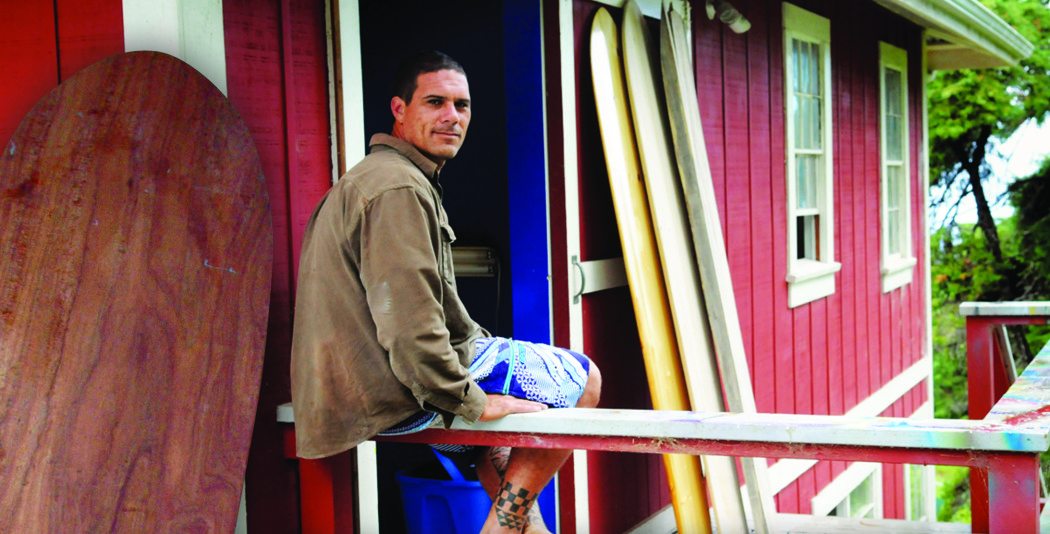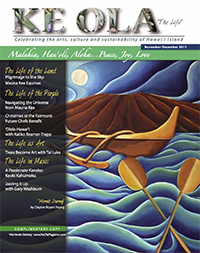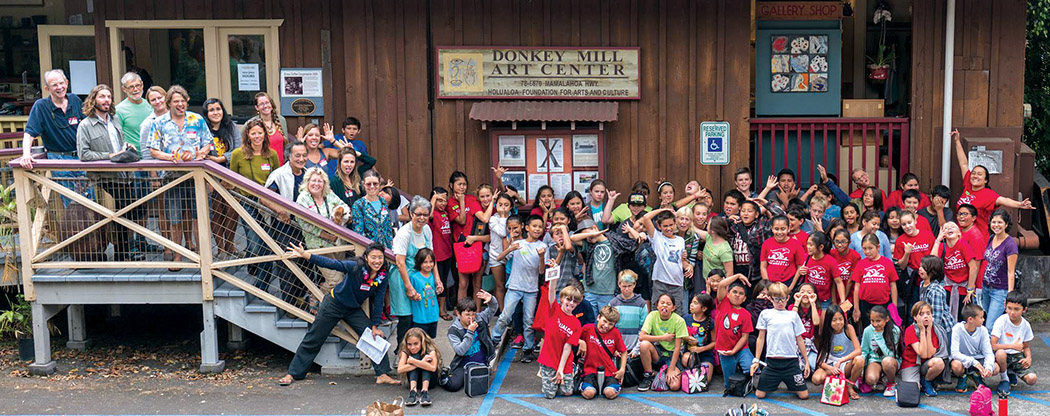
Crafting Papahe‘enalu: From Tree to Sea: Traditional Wooden Surfboard Shapers
 By Hadley Catalano
By Hadley Catalano
Every surfer remembers that first surfing experience…
When Bob Russell began as a child, he surfed on blue and yellow canvas rafts along the Kona Coast. When Keith Tallett grew up in Hilo his father couldn’t afford to buy his son a board, so he shaped him a foam one in the backyard. Carlos Kuhn had his first surfing adventure south of Moloka`i, on a racing canoe.
The story behind the legendary water vehicle has evolved, reshaped its curves and lines with time. The history behind papahe’enalu, or surfboards, is as old as the sport itself, and as the saying goes, history does repeat itself. Riding on the wave of the emerging Hawaiian renaissance, the ancient practice of wooden surfboard shaping has been revived, led by the renowned O`ahu surfer Tom “Pohaku” Stone.
Big Island surfboard shapers, such as Russell, Tallett and Kuhn, have all caught Stone’s contagious enthusiasm through their respective encounters with the legendary board builder. Inspired by Stone, each shaper has embraced and developed a unique style while adhering to the cultural accuracy of the craftsmanship of wooden boards. Keeping one eye ahead, these three have sought to look behind them too, to where surfing first originated, and to carry forth the original Hawaiian surfboard traditions.
While Polynesians all across the Pacific are widely accepted as the first to make evolutionary advances in riding waves and surfboard design, dating back as far as 1500 BC according to the Hilo-based Surf History Preservation Collection, early experts noted in their journals that they considered the Hawaiian surfboards — and surfers — to be superior to all others. Six-foot planks of wood seemed to be the standard height used among outer-lying Polynesian islands, but Hawaiian boards were made in a variety of sizes to accommodate wave differentials and surfers’ sizes and builds.

Boards were built of three pre-contact woods, ulu (breadfruit), wiliwili (a Hawaiian balsa, used only for ali`i, or royalty) and koa (a Hawaiian mahogany). Sizes ranged from the two- to five-foot paipo (the original knee or/and body board); the alaia, six to 12 feet; and the kiko`o, 12 to 17 feet (referred to as “Duke Style” board), up to the olo boards, 18 to 24 feet, that were carved to be ridden strictly by royalty. The larger boards varied in weight from roughly 77 to 150 pounds.
The physical design and shape of the surfboards were measured by eye and carved by hand, with handmade tools. Once the blank was split off a log, it was shaped into a rounded nose and a squared-off tail. The blank was then sanded with coral blocks, rubbed with sand, smoothed with water and sharkskin, and finished with kukui nut oil.
Over the centuries, the heavy wooden planks morphed into hollow boards (an invention by surfer Tom Blake in the 1920s) and with modern technology, the transformation continued into today’s lightweight and easily maneuverable foam and fiberglass boards with fins, leashes and rockers. The practicality and allure of shaping traditional boards was, for a period of time, lost, reminiscent only in museums and wall hangings.
Around 2004, Stone began to invest his energy into reviving a family heritage: the traditional Hawaiian shaping practices of wooden papahe`enalu. Russell, a woodworker in Holualoa, had access to koa wood.
“When he was shaping at my house, I began to learn through observation,” explained Russell, who is currently working on his 45th wooden board. “ I give my kumu respect; I wouldn’t be doing it without him.” As Russell went on to describe the details of the grains and twists of the wood, the movement of the drying planks and the time-consuming process of shaping a wooden board and finishing it with an oil coat, he stressed that there is a difference between traditional and nontraditional Hawaiian boards.
“Many people shape wooden board, but for example, an alaia is a specific type of board. To me it’s not an alaia if it’s not made from Hawaiian wood,” he said.
Russell has replicated a number of boards from the Bishop Museum collection, designed boards for professional wave riders and crafted boards for collectors on the East Coast. Each time, Russell connects intimately with each one of his boards and the entire shaping process. “There is history here on the Big Island. Writings from the time of Captain Cook talk about surfing,” said Russell, who is native Hawaiian, noting that the first surfer could possibly have surfed at Holualoa Bay (Lyman’s). “Hawaiians want to get into their culture, whether it’s through the resurgence of hula, our language, pounding poi or carving and riding a board. We want to connect to our roots, teach our children. Taking it from a standing tree to a finished, rideable board brings a lot of satisfaction. There are not too many people that can say they’ve done that.”
Following in the ways of his teachers, Carlos Kuhn, who resides in Āhualoa, has many similarities to the ways Stone (and Russell) have developed into wooden shapers. A tree trimmer in his mid 20s, Kuhn carries with him a board-shaping motto, “Bringing the tree to the sea.”
“I first took part in shaping a wooden board at Waimanalo beach with Uncle Pohaku [Stone],” said Kuhn, who became interested in wooden boards after a visit to Bishop Museum. “I like people who aren’t afraid to share knowledge. People who want to see other people strive.”
Studying at O‘ahu’s Marine Educational Training Center, he learned small-vessel fabrication and manufactured molded fiberglass canoes and a variety of custom composite parts. But, after the “seed was planted,” Kuhn returned to tree trimming, the occupation of his father when the young shaper was a boy. He stayed involved, however, with Stone’s shaping clinics organized in conjunction with non-profits aimed at sharing craftsmanship skills with Big Island children, and he quickly became enthralled with the beauty of shaping.
“Old boards have the most gradual tapers. Some were cumbersome for sure, but others were just the opposite. It had to do with the shaper and his experience in that time. Every board is an evolution of a mind in time. Kanaka had every tool at his disposal and already created all functional shapes used for riding this ocean. I don’t doubt that many would be considered artwork by today’s standards,” he said.
Harvesting the trees he fells, Kuhn utilizes what his clients discard. “We started using our resources to create functional artistry, which pays respect to the skills of older generations,” said the shaper, who has donated eight of his 10 boards, like the one on display at the new Eddie Aikau Restaurant in Waikoloa. “There is empowerment in giving someone the tools to create something to ride on. You can create a straight connection through the shaping of the board to its life from the mountain to the sea.”
Kuhn has kept a written account of all the boards he has made (as has Russell), describing in detail where the tree was felled, the type of tree (he has also shaped nontraditional boards out of mango and other local woods), the milling, the spline drawing, the rough shaping, the planning (with hand and power tools), sanding and finishing with both kukui nut and tung oil.
One plank Kuhn shaped was part of a dead wiliwili tree that came from Moloka`i. He finished the board and named it “Kipu`upu`u,” a name he says was suggested by Aunty Linda Bertelmann. He lent the alaia to his friend Hualalai Keohuloa, who surfed the board at Waipi‘o Valley—an empowering experience for both surfer and shaper.
“Surfing wooden boards feels like nothing else; it takes a lot of skill, but you are more connected,” Kuhn said, describing the humbling experience. “Hualalai is a versatile rider. He’s in tune with the ocean. In shaping these planks I have made relationships along the way and I get to see the trees make a connection when surfed in this ocean by friends.”
The board holds stories and those stories are shared out on the water, and it’s that cultural sustainability of board making that first sparked Tallett’s interest.
A native Hawaiian artist, Tallett earned a bachelor’s degree from UH-Hilo in 1995 and a master’s at the San Francisco Art Institute in 1999. Based in Pa’auilo, he and Stone have recently received a Cultural Apprenticeship Grant through the Folk and Traditional Arts Program at the Hawai`i State Foundation for Culture and the Arts. According to the Foundation, the grants are awarded to help masterful and accomplished teachers of the traditional arts share their knowledge in a deep and meaningful way with the experienced individuals who they feel are best equipped to carry on the tradition.
Having grown up immersed in the surf culture in Hilo with homemade foam, fiberglass and resin boards made by his father, Tallett joked that he learned to shape through osmosis. Though kidding aside, the shaper did learn to shape out of necessity.
Over the years, and with growing maturity, Tallett’s youthful embarrassment turned into gratitude as he realized the importance of expressing himself through art and the connection to his culture through board shaping. However, it wasn’t until a few years back when Clark Foam, the company from which Tallett and his father bought supplies, went out of business, that Tallett turned to wood and back to the basics.
“It sparked an interest that I had to engage with the board physically,” said the artist. “It’s a utilitarian craft. I wanted to participate in the grant so that I could one day teach the knowledge.” He explained that he was first introduced to Stone through a workshop at Pine Trees, a surf spot in Kona.
“He got everyone interested. He said, ‘Here’s a chainsaw and pencil, let’s go,’” said Tallett, explaining that through cultural protocol, Stone is his guide, teaching him the way. “It is comforting to know that if it doesn’t work out the first time, you can make another. It’s okay to mess up.”
Tallett will be apprenticing with Stone over the course of the next year and through the grant will detail a plan to help preserve traditional board building and share it with others. This plan has led Tallett to find a kindred spirit in Kuhn. Both have connected over the positive repercussions of providing Hawaiian children with a sense of tradition, perpetuating the culture by sharing, inspiring self-sustainability and not to mention the biodegradable novelty of wood.
“In the Hawaiian culture there really is no word for art. Everything was made for its usefulness and practicality,” said Tallett, a founding member of AGGRO culture, a Hawai`i based art collective, who, along with Russell and Kuhn, will be featured at the Kahilu Theatre exhibition ‘Contemporary Hawaiian Crafts’ through November 27. “When I met and worked with Pohaku, what struck me most was his commitment to passing on knowledge, his openness to sharing the tradition. I feel that for our traditions to remain living, we have to practice them. I believe that not only should the art of crafting wooden boards continue, but we should celebrate and give them life by using them and teaching the next generation.”
It’s been a welcome homecoming for papahe`enalu. The recovery of the traditional boards — as art, but above all for cultural and practical usage — has begun to circulate around Hawai`i Island, finding a place once again beneath the accomplished feet of Hawaiian surfers. ❖
Contact writer Hadley Catalano at hadleycatalano@gmail.com.
Resources:
Surf History Preservation Collection, Hilo.
Kahilu Gallery exhibition at Kahilu Theatre: “Contemporary Hawaiian Crafts,” Oct. 18 – Nov. 28, Monday – Friday, 9 a.m. – 3 p.m.


